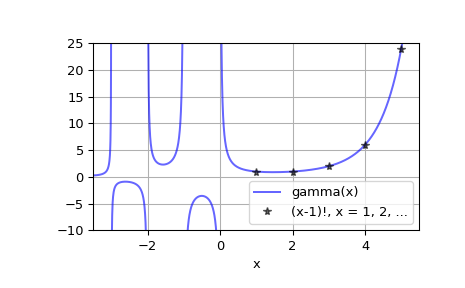scipy.special.gamma#
- scipy.special.gamma(z, out=None) = <ufunc 'gamma'>#
伽马函数。
伽马函数定义为
\[\Gamma(z) = \int_0^\infty t^{z-1} e^{-t} dt\]对于 \(\Re(z) > 0\),并通过解析延拓扩展到复平面的其余部分。更多详情请参阅 [dlmf]。
- 参数:
- zarray_like
实数或复数值参数
- outndarray, 可选
可选的函数值输出数组
- 返回:
- 标量或 ndarray
伽马函数的值
说明
伽马函数常被称为广义阶乘,因为对于自然数 \(\Gamma(n + 1) = n!\)。更一般地,对于复数 \(z\),它满足递推关系 \(\Gamma(z + 1) = z \cdot \Gamma(z)\),这与 \(\Gamma(1) = 1\) 的事实相结合,意味着当 \(z = n\) 时上述恒等式成立。
伽马函数在非负整数处有极点,当 z 接近每个极点时,无穷大的符号取决于接近极点的方向。因此,一致的做法是让 gamma(z) 在负整数处返回 NaN,当 x = -0.0 时返回 -inf,当 x = 0.0 时返回 +inf,使用零的符号位来表示接近原点的方向。例如,这是 Iso C 99 标准 [isoc99] 附录 F 第 9.5.4 条中对伽马函数的建议。
在 SciPy 1.15 版本之前,
scipy.special.gamma(z)在每个极点处返回+inf。这在 1.15 版本中得到了修复,但带来了以下后果。当伽马函数出现在分母中的表达式,例如gamma(u) * gamma(v) / (gamma(w) * gamma(x))如果分子定义良好但分母存在极点,则不再计算为 0。相反,此类表达式会计算为 NaN。在这种情况下,我们建议改用函数
rgamma来表示倒数伽马函数。上述表达式例如可以写为gamma(u) * gamma(v) * (rgamma(w) * rgamma(x))参考文献
[dlmf]NIST 数学函数数字库 https://dlmf.nist.gov/5.2#E1
示例
>>> import numpy as np >>> from scipy.special import gamma, factorial
>>> gamma([0, 0.5, 1, 5]) array([ inf, 1.77245385, 1. , 24. ])
>>> z = 2.5 + 1j >>> gamma(z) (0.77476210455108352+0.70763120437959293j) >>> gamma(z+1), z*gamma(z) # Recurrence property ((1.2292740569981171+2.5438401155000685j), (1.2292740569981158+2.5438401155000658j))
>>> gamma(0.5)**2 # gamma(0.5) = sqrt(pi) 3.1415926535897927
绘制实数 x 的 gamma(x)
>>> x = np.linspace(-3.5, 5.5, 2251) >>> y = gamma(x)
>>> import matplotlib.pyplot as plt >>> plt.plot(x, y, 'b', alpha=0.6, label='gamma(x)') >>> k = np.arange(1, 7) >>> plt.plot(k, factorial(k-1), 'k*', alpha=0.6, ... label='(x-1)!, x = 1, 2, ...') >>> plt.xlim(-3.5, 5.5) >>> plt.ylim(-10, 25) >>> plt.grid() >>> plt.xlabel('x') >>> plt.legend(loc='lower right') >>> plt.show()
